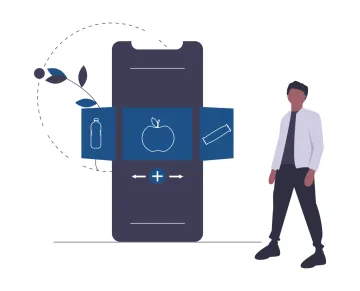
Design Your Pathway to Wellness
Use this Personal Wellness Plan to create a path to wellness that’s right for you. Come back to these questions often as the semester goes on to stay on track with your wellness goals.
Follow the steps below to create your Personal Wellness Plan or download the fillable Personal Wellness Plan Worksheet.
Personal Wellness Plan Worksheet
The following steps can also be found on the Personal Wellness Plan worksheet.
Step 1:
Take Inventory. Fill in the chart below to reflect your wellness in each domain right now using the following scale. Write your rating in the boxes below.
0= totally lacking
1= significantly lacking
2= moderately lacking
3=half lacking, half fulfilled
4=slightly fulfilled
5=relatively fulfilled
6=completely fulfilled
Domains of Wellness
Academic Wellness
School, time, and graduation. Includes your school satisfaction, performance, relationships, and progress toward graduation.
Rating: ________
Emotional Wellness
Understanding and responding to your emotions. Includes positive emotional experiences and how you respond to life's challenges.
Rating: ________
Environmental Wellness
Your sense of safety, comfort, and connection with your physical surroundings.
Rating: ________
Financial Wellness
Includes your earning, spending, and saving practices and comfort/satisfaction with your financial situation.
Rating: ________
Interpersonal Wellness
Your daily interactions, the qualities of your relationships, and your satisfaction with time spent interacting with others.
Rating: ________
Occupational Wellness
Includes job satisfaction, performance, and professional development.
Rating: ________
Physical Wellness
How you experience your body. It includes physical activity, nutrition, medical care, body image, and energy/vitality.
Rating: ________
Spiritual Wellness
Your sense of connection to something larger than yourself, values, meaning, ethics, or faith.
Rating: ________
Stage of Life Wellness
Includes life skills and experience, problem-solving and decision-making, and self-awareness.
Rating: ________
Optional Step 1B:
It can be helpful to visualize the domains of wellness together in a wellness wheel. If you have a sheet of paper you can draw on, fill in the chart below using your ratings from above. *You can also complete a free wellness wheel assessment online.
Shade the number of spaces that reflects your wellness in this area:
0= totally empty (no spaces filled)
1= significantly empty
2= moderately empty
3=half empty, half full
4=slightly full
5=relatively full
6=completely full (all spaces filled)

Step 2: Take a minute to reflect on this experience.
What were your gut reactions to filling out this chart?
Step 3: Name what's working.
What domains of life are working the best right now? What can you learn from this?
Step 4: Identify your efforts.
In which domains have you invested your time, energy, and effort? What does this say about your values and priorities? What can you learn from this?
Step 5: Name opportunities for growth.
What domains are struggling right now? Where are you stuck? Try to come at this question with the attitude that this is an opportunity for growth rather than a failure.
Step 6: Make your plan.
List one to three domains of wellness that you'd like to explore further. You could choose to strengthen an already thriving domain or give extra attention to an opportunity for growth.
Next, review the tips and resources for those domains available through Pathways to Wellness.
After you've reviewed the tips and resources, name at least one SMART goal for each domain you listed. SMART stands for: specific, measurable, actionable, reasonable, and timely. Try to phrase your goal in a way that lets you know exactly what you intend to do, how you'll know when you've achieved it, and when you plan to assess your progress.
Examples of SMART goals:
- Get at least 7 hours of sleep 3 nights in the next week.
- Contact my advisor to set up an appointment in the next week.
- Buy a planner for school tonight.
What are your SMART goals?
Step 7: Use your resources.
There are so many resources available to Arizona students. Use these links to explore the resources available to you in each domain of wellness. Name at least one resource you'd like to utilize as part of your Personal Wellness Plan.
What resource(s) would you like to use or learn more about?
Step 8: Seal it in with a quick imagination exercise.
Before you go, take a few minutes to imagine what it will look like to work toward the goals you set.
Begin by settling yourself. Find a comfortable place to sit and allow your eyes to rest on an object in your environment. Try to notice your peripheral vision as you do this. Let your body relax and your mind focus on the goals you'd like to work on.
From this place, consider these questions.
- What would you see, feel, hear, smell, taste while working toward this goal?
- What would working toward this goal do for you emotionally? Physically? Mentally? What other outcomes can you expect from working toward this goal?
- What deeper meaning or purpose does this goal have in your life? How would things change for the better if you achieved this goal?
- Write down a word or phrase that reminds you of your goal and the deeper meaning behind it. Return to this word whenever you need a boost in energy or motivation.

You're all set! Come back to your Personal Wellness Plan to review your goals and assess your progress.
Bonus Tips for Setting Goals and Building Healthy Habits


Don’t try to give your whole life a makeover overnight. Instead, set yourself up for sustainability and success. Consider the change that would be most meaningful in your life and start there. Name a few baby steps you could take toward your desired goal. Approaching a habit-change this way reduces resistance and helps set you up for early success. The faster you feel successful in working toward your goal, the more motivated you will feel to keep it up.

Use the acronym SMART when stating your goals. SMART stands for specific, measurable, actionable, reasonable, and timely. Setting concrete and specific goals will help you start simple and have an early win.

Making a change that sticks requires repetition. It can take at least 1-2 months for a new behavior to become a habit. Decide now that you are committed to committing to this goal. Remember to start simple and build from there.

Consistency is critical when it comes to making a change. The more you repeat a new action, the faster it becomes a habit.

It’s normal to forget about a new behavior a week or two into it. Prepare for forgetting by building in reminders. Add notes to your planner, set alarms, or post signs in places you often look. You might also like to wear a symbolic reminder, like a special charm or piece of jewelry that reminds you of the change you’d like to make.

Find someone who will go along with you and keep you motivated if you feel like quitting.

If your new healthy habit involves giving something up, be sure to adequately replace any needs you’ve lost. For example, If watching television gave you a way to relax but you want to reduce your screen time in the evening, you could take up meditation or reading as a way to replace that same need.

That is, build your environment around your new goal. Remove temptations to engage in an old behavior and make the old behavior inconvenient or inaccessible. At the same time, make the new behavior easy and convenient. For example, if you wanted to start going for walks in the morning, lay out your walking clothes and a water bottle the night before and place them in the first place you’d look.

Give yourself a timeframe to explore in and withhold judgment during that time. Think of it as an experiment. Experiments can’t fail, they just give you information about what does and doesn’t work for you.

Don’t worry about all the things you “should” have as habits. Instead, focus on the areas of wellness you’d like to build upon and the changes that would be most meaningful to you.

